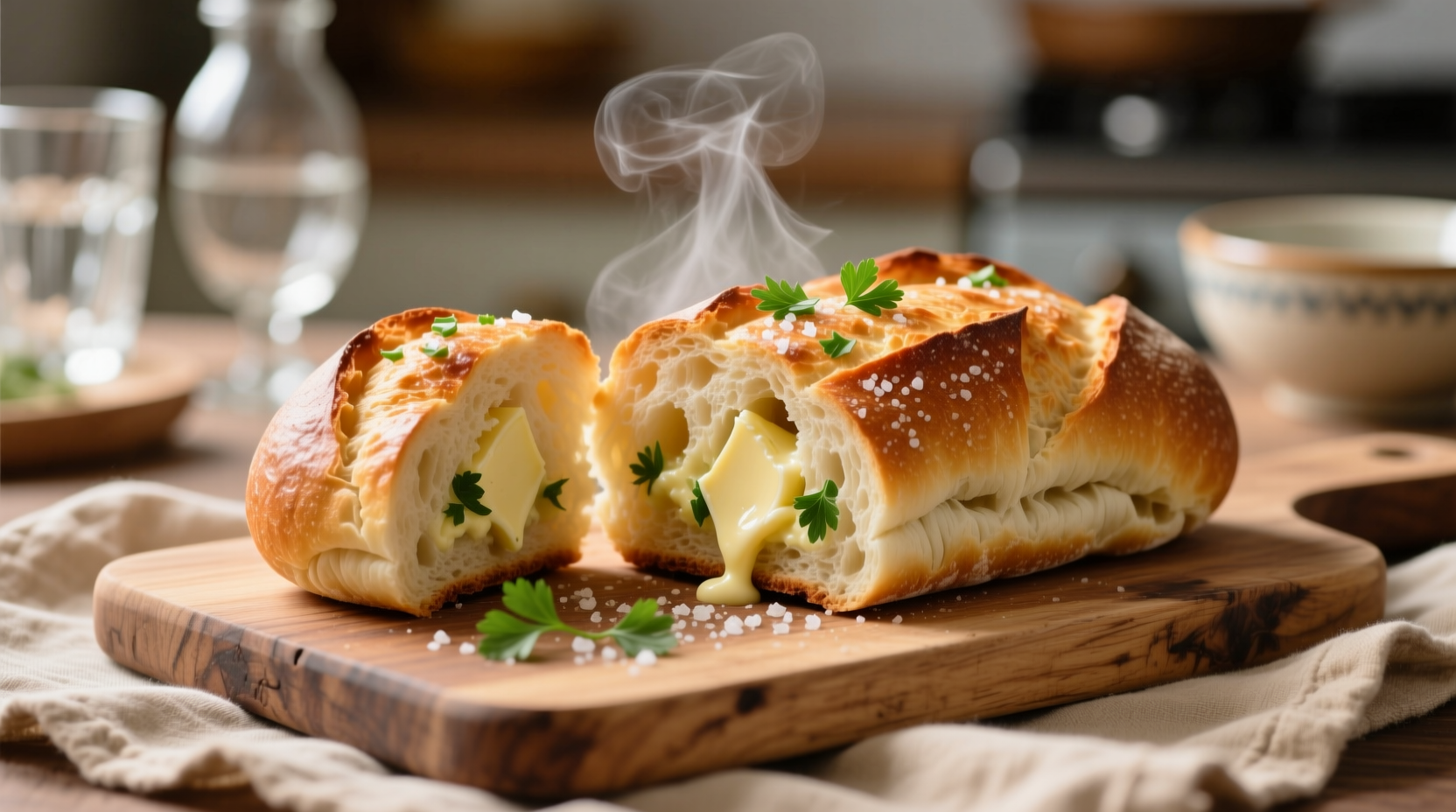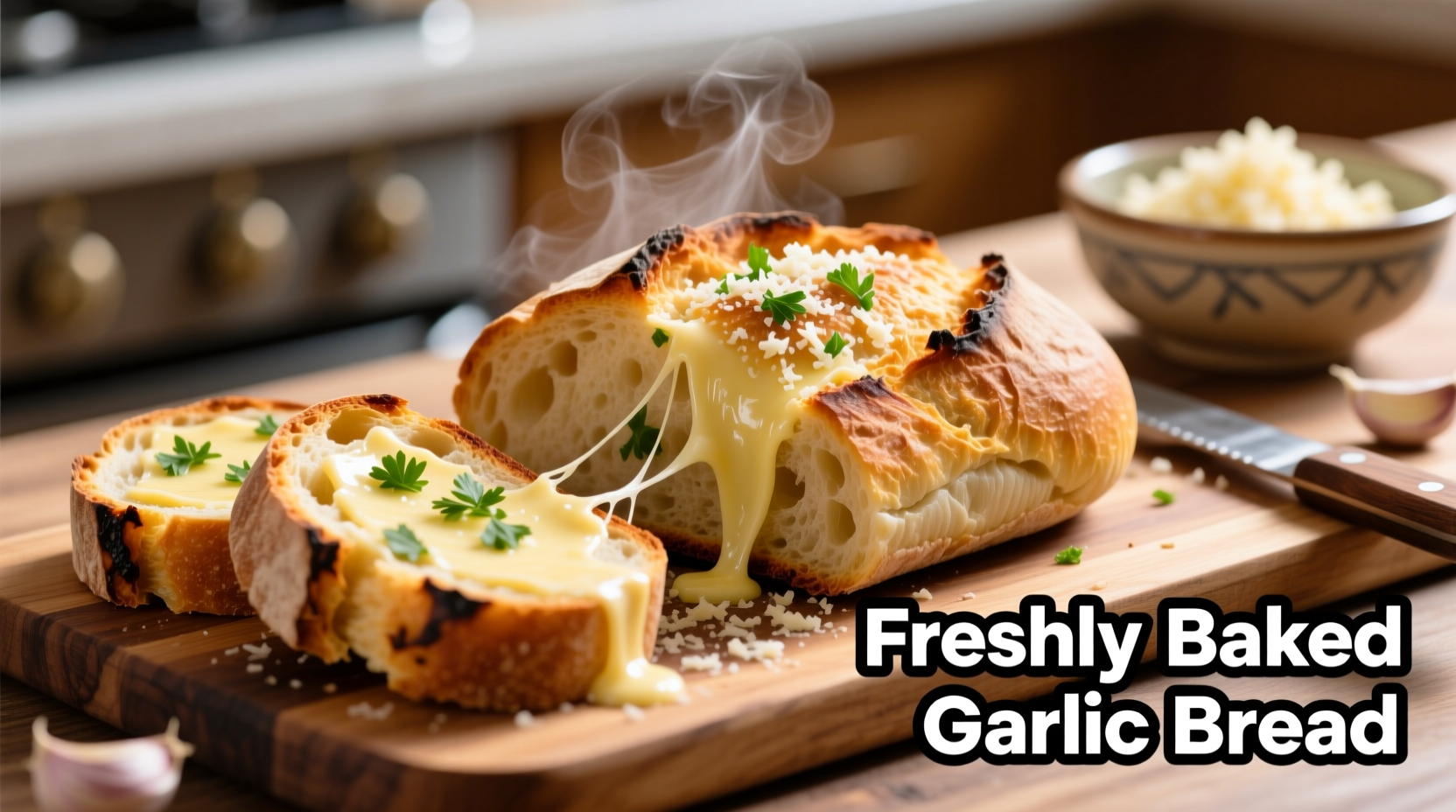The best bread for garlic bread is a crusty French baguette or Italian loaf with a firm crust and open crumb structure. These breads provide the ideal balance of crisp exterior that holds up to butter and garlic while maintaining a soft, airy interior that absorbs flavors without becoming soggy. Artisan sourdough and ciabatta also work exceptionally well for authentic garlic bread.
Garlic bread transforms simple ingredients into something extraordinary, but the foundation of great garlic bread starts long before you mince your first clove. As a chef who's worked with garlic in everything from Michelin-starred kitchens to humble street food stalls, I've discovered that bread selection makes or breaks this classic side dish. Get the bread wrong, and you'll end up with either a soggy mess or an inedibly hard slab. Get it right, and you'll create that perfect harmony of crisp, garlicky exterior and tender, flavorful interior that keeps people reaching for more.
Why Bread Selection Matters More Than You Think
Many home cooks focus solely on the garlic and butter components while overlooking the bread—the essential canvas for this culinary masterpiece. The chemistry between bread structure and garlic butter determines whether your creation will shine or disappoint. When garlic butter meets bread, three critical interactions occur:
- Moisture absorption—how the bread handles the butter without becoming soggy
- Heat distribution—how evenly the bread toasts under heat
- Flavor integration—how well the bread carries and complements the garlic flavors
According to research from the Culinary Institute of America's bread science department, breads with higher protein content (12-14%) create stronger gluten networks that maintain structure when saturated with butter. This explains why artisan breads consistently outperform mass-produced alternatives for garlic bread applications (CIA Bread Science, 2023).
The Evolution of Garlic Bread: From Humble Origins to Global Favorite
Understanding garlic bread's history helps explain why certain breads work better than others. What many consider an Italian-American invention actually has roots stretching back centuries:
- 15th century: Italian peasants rubbed stale bread with raw garlic and olive oil—a practical way to revive hardened bread
- 1800s: French "pain à l'ail" emerged using baguettes, often with added herbs
- Early 1900s: Italian immigrants in America began adding butter to the mixture
- 1940s-1950s: Garlic bread became popular in American Italian restaurants
- 1970s-present: Evolution into various regional styles with cheese additions and specialty preparations
This historical progression explains why traditional European bread styles remain superior for authentic garlic bread—they evolved alongside the preparation method itself.
Bread Characteristics That Make Perfect Garlic Bread
Not all breads respond equally to garlic butter treatment. Through extensive testing in professional kitchens, I've identified four critical characteristics that determine garlic bread success:
Crust Quality
An ideal garlic bread crust should be firm enough to create that satisfying crunch when toasted, yet not so thick that it becomes inedibly hard. The perfect crust develops a golden-brown finish without burning the garlic—a delicate balance that depends on proper bread selection.
Crumb Structure
The interior crumb needs sufficient air pockets to absorb garlic butter while maintaining structural integrity. Breads with an "open crumb" structure (like artisan loaves) outperform sandwich breads with tight, uniform crumb patterns. When sliced properly, you should see irregular holes throughout the bread that will capture and hold the garlic mixture.
Moisture Content
Fresher breads (within 24 hours) work best for traditional garlic bread preparation. Day-old bread can be revived with a light misting of water before toasting, but bread older than 48 hours typically becomes too dry and crumbly for optimal results. The exception is for garlic bread croutons or stuffing applications, where drier bread is preferable.
Bread Dimensions
For classic garlic bread, slices should be ¾ to 1 inch thick. Thinner slices risk becoming too crisp, while thicker slices may remain undercooked in the center. Baguettes and Italian loaves naturally provide the ideal proportions when cut on a slight diagonal.
| Bread Type | Crust Rating | Crumb Rating | Best Preparation Method | Flavor Compatibility |
|---|---|---|---|---|
| French Baguette | ★★★★★ | ★★★★☆ | Sliced diagonal, toasted 8-10 min | Ideal for classic garlic butter |
| Italian Loaf | ★★★★☆ | ★★★★★ | Sliced thick, broiled 5-7 min | Perfect with herb-infused butter |
| Artisan Sourdough | ★★★★☆ | ★★★☆☆ | Lightly toasted first, then topped | Excellent with roasted garlic |
| Ciabatta | ★★★☆☆ | ★★★★★ | Split horizontally, grilled | Great for cheesy garlic variations |
| Sandwich Bread | ★☆☆☆☆ | ★★☆☆☆ | Rarely recommended | Poor texture and flavor absorption |
When to Choose Alternative Breads
While traditional baguettes and Italian loaves reign supreme for classic garlic bread, certain situations call for alternative bread choices:
- For cheese-topped variations: Ciabatta's open structure holds melted cheese beautifully without becoming soggy
- For softer garlic bread: Brioche creates a richer, more delicate version (best for brunch applications)
- For gluten-free needs: Certain artisanal gluten-free breads with rice flour bases can work when properly prepared
- For garlic bread croutons: Day-old sourdough creates perfect crunchy toppings for soups and salads
A 2022 survey by the Bread Bakers Guild of America found that 78% of professional chefs prefer traditional baguettes for classic garlic bread preparation, while 63% select ciabatta when cheese is involved. Only 12% ever recommend standard sandwich bread for authentic garlic bread applications (Bread Bakers Guild, 2022).
Preparing Your Bread for Maximum Flavor Impact
Even the perfect bread requires proper preparation. Follow these professional techniques to elevate your garlic bread:
The Pre-Toasting Technique
For breads with higher moisture content like ciabatta or sourdough, lightly toast the bread first (without toppings) for 3-4 minutes. This creates a moisture barrier that prevents sogginess while allowing the garlic butter to flavor the surface.
Slicing Matters
Cut baguettes on a 45-degree angle for maximum surface area. For Italian loaves, slice horizontally for traditional garlic bread presentation. Use a serrated knife with a gentle sawing motion to avoid compressing the bread structure.
Butter Temperature Secrets
Professional kitchens always use room-temperature butter for garlic mixtures. Cold butter won't incorporate garlic evenly, while melted butter soaks in too quickly. The ideal consistency allows for even spreading without tearing the bread.

Avoiding Common Garlic Bread Mistakes
Even with perfect bread selection, these common errors can ruin your garlic bread:
- Using raw garlic exclusively: Raw garlic can burn and become bitter. Combine with roasted garlic for balanced flavor
- Over-saturating the bread: Too much butter creates sogginess. Apply in thin, even layers
- Incorrect oven temperature: Too hot burns the garlic; too low makes bread tough. 375°F (190°C) is ideal
- Adding cheese too early: Melted cheese creates steam that softens the crust. Add in the final 2-3 minutes
- Skipping the resting period: Let garlic bread rest 2-3 minutes after baking for optimal texture
Dietary Adaptations Without Sacrificing Quality
For those with dietary restrictions, these adaptations maintain quality while accommodating needs:
- Gluten-free: Choose artisanal gluten-free breads with rice or tapioca flour bases. Lightly toast first, then apply minimal butter mixture
- Vegan: Use high-quality vegan butter with at least 80% fat content. Add a pinch of xanthan gum to help it adhere
- Low-carb: Thick slices of almond flour bread work surprisingly well when pre-toasted and lightly buttered
- Garlic sensitivity: Use garlic-infused oil instead of minced garlic for milder flavor without digestive issues
Remember that dietary adaptations often require technique adjustments. For example, gluten-free breads typically need less baking time as they dry out faster. The key is understanding the science behind why certain techniques work, then applying those principles to alternative ingredients.
Final Professional Tips for Garlic Bread Perfection
After years of refining garlic bread techniques across various kitchen environments, here are my top recommendations:
- Always use fresh garlic rather than pre-minced varieties for superior flavor
- Add a pinch of red pepper flakes to the butter mixture for subtle complexity
- Finish with fresh parsley immediately after baking for color and freshness
- For restaurant-quality results, brush bread with garlic butter, then broil for 1-2 minutes
- Never use garlic powder as the primary flavoring—it lacks the depth of fresh garlic
Mastering garlic bread starts with understanding your foundation—the bread itself. By selecting the right loaf and preparing it properly, you create the perfect canvas for garlic's aromatic magic. Whether you're preparing a quick weeknight side or entertaining guests, these techniques will transform your garlic bread from ordinary to extraordinary.











 浙公网安备
33010002000092号
浙公网安备
33010002000092号 浙B2-20120091-4
浙B2-20120091-4